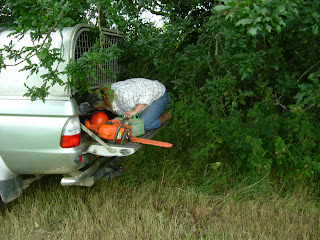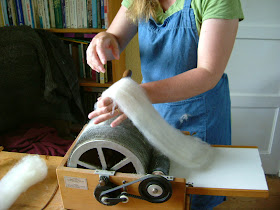No wonder Peggy has so many loyal customers. Her sausages are made of the best pork cuts, plus rusk, seasonings, and a bit of water just to bind the mix. That's it. She gave me sections to de-bone and break down so she could mince them. My job was to remove bones, rind (skin), any veins, glands, excess fat, or bruised meat. Peggy won't have any of that nonsense in her sausages.
It sounds a horrible job, but it really isn't. If you've ever had any interest in anatomy it's fascinating from that angle alone. While I cut, she gives me tips on how to hold my knife better (and safer), or where I can seam a joint to make it easier to remove fat. As I get more comfortable with the knife, I can break down the joints quicker. I'm still miles off Peggy's speed though, even with her thumb in traction.
Peggy asked had I ever made sausages before. I had not. I had seen sausages hanging in a butcher's window before and that was the sum total of my experience, besides eating them of course.
Sausages are linked in groups of three, strung together like Christmas lights-
www.imancasing.com/images/north_fife_butchers_traditional_sausages.jpg
This looked like skilled labor to me. We had over 50 pounds of sausages to make for the wedding and for customers' orders so I needed to get skilled - fast.
I rinsed the natural casings out, which are preserved in brine. Washing them removes the excess salt. Peggy filled them, then demonstrated the technique: pinch and twist, make another, twist and push through the first two, pull up, pinch in half, twist that pair and start again. Easy, right?
Yeah. It made that much sense to me too.
But as I watched her, I realised it was no different than making a basic chain stitch, a common stitch used in knitting and embroidery. It's the basic stitch on your sewing machine -
Apparently it's also a great way to link your sausages.
Here's a case where a skill learned in one discipline translates directly to another. Who'd have thought there would be an obvious link between knitting and butchery. (Hey, maybe that's where the term "link sausages" derives from?). Of course you don't need needles to knit sausages, and my knitting wool doesn't burst out of its casing when I'm making a sweater, but you can see where I'm going with the comparison.
Once I got the hang of chain stitching sausages, I made 100 chipolata sausages (little ones) and too many big sausages to count. Customers were buying them as quickly as Peggy and I could make them. Peggy sold them with the caveat "They haven't had 24 hours to dry in the chiller, so don't eat them right away. Leave them in your fridge overnight. And don't put anything heavy on them in the car!" She puts a lot of care into her meat and a split, wet sausage is unacceptable. It doesn't do justice to her work or the pig's.
I must have passed the test (she didn't see me re-twist and titivate a few that loosened in the chiller) as she's asked me to come on a more regular basis to help in the butchery. For money. An actual job! Supplementary to my gamekeeper's wife job working dogs, cooking for the staff, and vermin control. But like knitting and butchery, the two jobs have shared skill sets. Though I'm not sure the words "unskilled" and "butchery" sound good in a job title .
I know where I will be spending my first paycheck. If Peggy hasn't run out of sausages by then.














































